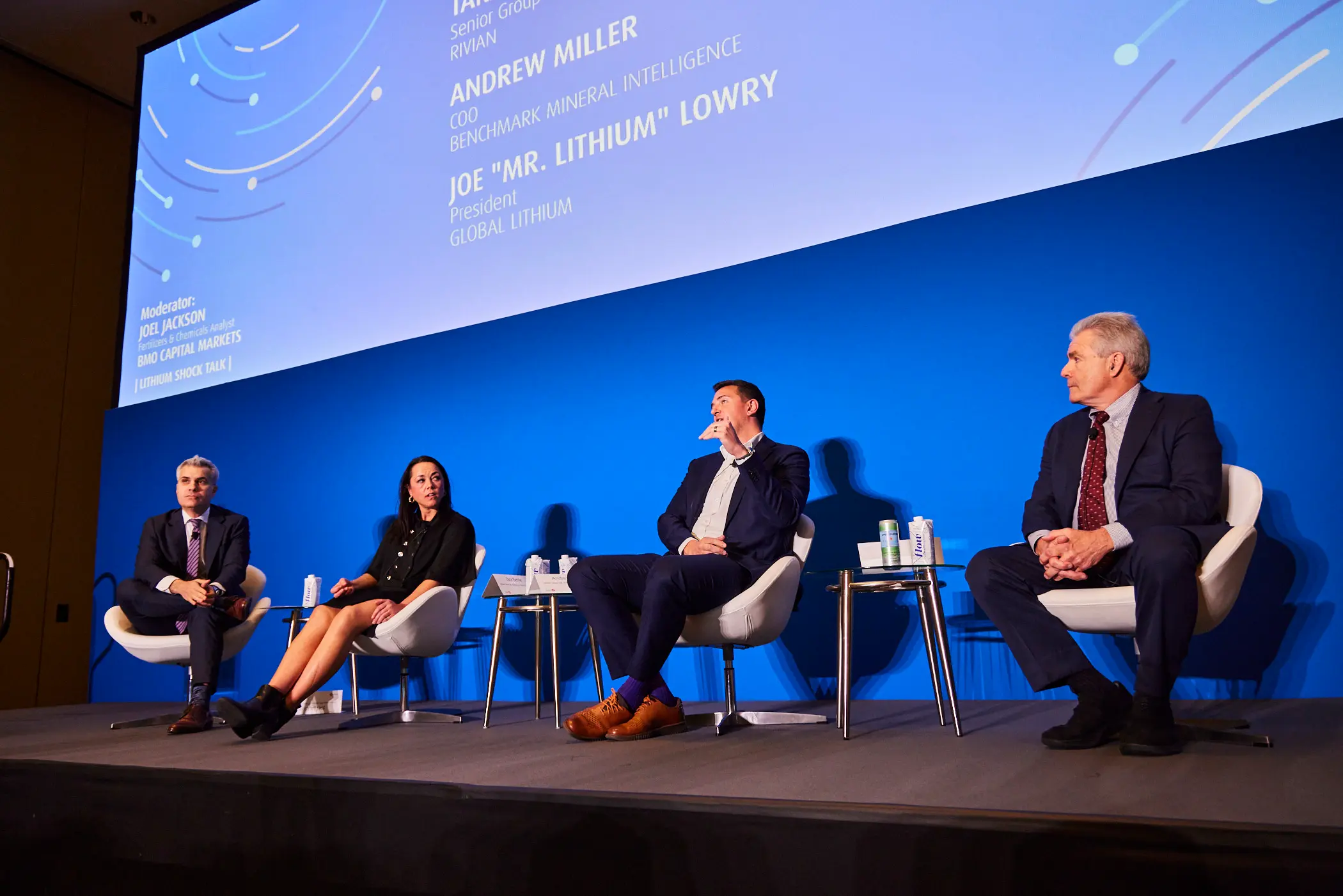Le contenu de cet article sera accessible en français à une date ultérieure. Restez à l’affût!
The demands of the energy transition and supply realities will likely support lithium markets this year, but greater supply chain efficiencies will be needed over the long term.
These themes were in focus during the “Lithium Shock Talk” panel at the BMO Capital Markets 33rd Global Metals, Mining & Critical Minerals Conference. To help break down the challenges, I sat down with Tara Berrie, Senior Group Manager (Battery Metals, Recycling, Components & ESG) for Rivian, Andrew Miller, Chief Operating Officer for Benchmark Mineral Intelligence, and Joe Lowry, President of Global Lithium.
Significant volumes of metals and critical minerals are needed to help economies shift away from hydrocarbons, though none are as correlated to the electric vehicle (EV) market as lithium. The global annual passenger EV sales growth rate dropped to around 30 percent in 2023 from roughly 60 percent in 2022 and is expected to slow further in 2024, according to BloombergNEF.1
Lithium prices
Slowing annual sales growth in EVs and macroeconomic uncertainty have contributed to a price decline in lithium, but that is expected to change later this year. As Rivian’s Tara Berrie pointed out, inventory levels are currently very low, explaining that lithium is entering “a perfect environment for it to see a very pronounced V-shaped recovery, but it depends on what the catalyst is for that recovery.”
Timing aside, Global Lithium’s Joe Lowry expects a faster rebound than the previous price cycle. “People are overestimating the amount of supply or new supply that will come into the industry,” he noted.
Among the challenges with forecasting the lithium market are limited visibility in all parts of the lithium battery supply chain, the need for higher quality data, and a reliable industry benchmark. The industry needs a better way to link what’s happening in EV demand with lithium supply to get a better read on the market, said Miller. “If you can tie those two together, then market intelligence can be pretty good,” he explained. “But our supply chain is quickly evolving, and it makes it very challenging for anyone operating in this industry to have complete clarity.”
Changes in the supply chain
The supply chain changes Miller referred to are happening midstream, where the raw material is being refined rather than EV manufacturers.
According to Berrie, there needs to be more collaboration between the miners and the OEMs, even when there is not a direct contractual relationship. “Miners need to be equipped with the information around what is happening with demand so that they can de-risk their investments, because the middlemen don’t have great insight,” she explained.
Miller agrees with Berrie’s assessment that more flexibility is needed in the supply chain. “It’s very interesting to see where the cathode and battery producers actually position themselves along that supply chain,” he said. “If you really want to open yourself up to different pools of material, then you’re going to need to control some element of that refining process.”
And Miller argues midstream companies may be better positioned to do some of the refining and put the material to use, although he is careful to note that there will still be value created outside of those midstream players. “There needs to be some interaction and integration with the midstream that is for the good of the industry to have that happen,” he noted.
As part of that process, Lowry would like to see more transparency around the makeup of batteries and what the cathode of the future will be. “We’re moving into an industry where there’s so many applications for these batteries that there won’t be one size fits all,” he said. “The quicker we can get an appreciation and understanding of what the chemistry mix will be, then we can more effectively deploy capital.”
The future of lithium
Between the uneven stockpiles and demand for lithium, and the shifts occurring within the supply chain, the panel expects to see volatility in this market for some time.
The U.S. Inflation Reduction Act of 2022, while intended to be a boost for industries tied to the energy transition, may further complicate matters. As the panel pointed out, the planned gigafactories may create more supply issues as those factories ramp up.
“You’re going to have a significant volume of rejected materials that will need to be recycled. The impact is two-fold – a delay in lithium getting into useable battery cells and losses during the recycling process,” said Lowry, referring to the experience from many existing gigafactories in the first few months of their operations. While the market models may show an oversupply, Lowry warned inefficiencies in the gigafactory buildout could result in a meaningful shortage of the critical metals.
The path toward electrification was never going to be a smooth one, but any pullback on EV production from automakers will only be temporary, said Miller. There is still a sense of urgency to get EVs to market. “This is an opportune time,” he said, “for a lot of those companies to start making some more strategic investments along the supply chain.”
